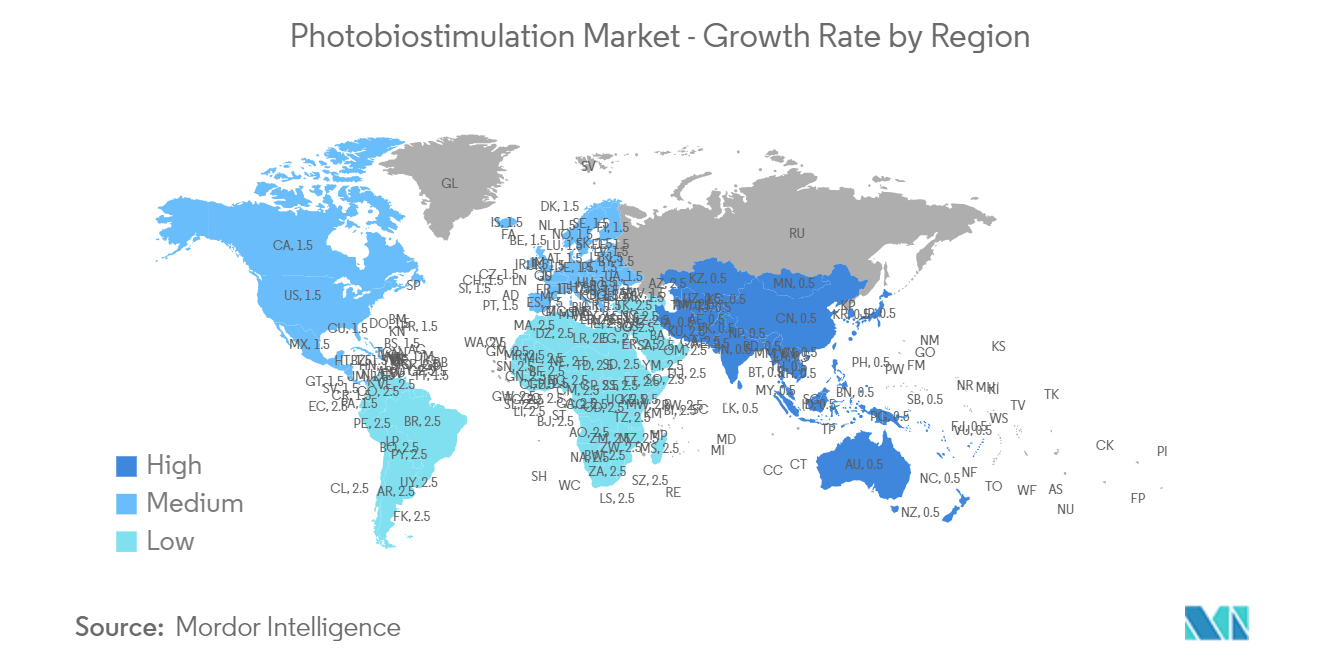Market Trends of Photobiostimulation Industry
Pain Management is Expected to Hold the Major Market Share in the Market Over the Forecast Period
Photobiostimulation has been explored for pain management with promising results. The benefits include the reduction of pain intensity, inflammation, and the promotion of tissue repair. In this application, low-level light therapy helps modulate cellular processes, influencing the release of endorphins and reducing inflammatory mediators. Conditions like musculoskeletal pain, arthritis, and neuropathic pain may benefit from photobiostimulation.
Low-level light therapy (LLLT) has been shown to have anti-inflammatory effects, helping to decrease swelling, alleviate pain associated with inflammatory conditions, and trigger the release of endorphins, the body's natural painkillers, providing a natural way to manage pain without relying solely on medication.
The growing burden of several diseases that elevate pain, such as arthritis and surgeries, and the growing application of LLLT in pain management is expected to contribute to the segment growth over the forecast period. Physical pain has trended upward globally over the last decade. For instance, according to the study published in Economic and Human Biology in January 2024, the pain prevalence across 146 countries worldwide revealed that 33.3% of people were in pain in 2019, 32.8% in 2020, 32.5% in 2021, and 34.1% in 2022. Thus, growing pain prevalence across the world is expected to increase demand for photobiostimulation therapy, thereby boosting the segment growth.
Moreover, according to the United States Pain Foundation report published in July 2022, 50 million Americans live with chronic pain or pain that lasts most days or every day for three months or more. Thus, the high burden of chronic wounds and the application of photobiostimulation therapy in wound care is anticipated to boost segment growth over the first period.
The growing burden of diseases that lead to pain is expected to contribute to segment growth. For instance, according to the Australian Bureau of Statistics published in December 2022, approximately 3.7 million (14.5%) people had arthritis in 2022. The proportion is almost seven times higher for people aged 45–54 years than for those aged 0–44 years (16.2% compared to 2.5%). Severe/very severe bodily pain was experienced by the patient suffering from arthritis. Thus, the growing burden of pain-related diseases also propels the growth of the segment.

North America is Expected to Hold a Significant Share in the Market During the Forecast Period
The North American region possesses a highly sophisticated healthcare infrastructure with an extensive network of advanced hospitals and surgical facilities well-equipped with cutting-edge technology, facilitating the widespread adoption of photobiostimulation treatment. The region is expected to have significant market growth over the forecast period, mainly attributed to the rising prevalence of chronic diseases like osteoporosis and arthritis, and the increase in technological advancements is expected to boost market growth over the forecast period. In addition, market growth is also fueled by the increasing geriatric population, rising focus on non-invasive treatments, growing demand for pain management treatments, and increasing focus on sports medicine. The increasing prevalence of sports-related injuries and the rise in the number of wound injuries in the region eventually increase the demand for various photobiostimulation treatments, for instance, according to the injury facts provided by the National Safety Council of the United States, sports and recreational injuries increased by 12% in 2022. The injuries related to exercise and exercise equipment increased slightly from 2021, from 409,224 injuries in 2021 to 445,642 injuries in 2022. This rising incidence of sports-related injuries is driving the demand for photobiostimulation as an effective and non-invasive therapeutic modality for accelerated recovery and pain management in athletes.
Moreover, rising demand for minimally invasive surgery (MIS) among patients also propels the market’s growth. The rise in the preference for MIS surgeries is rooted in the perceived advantages of MIS, such as faster recovery times, reduced pain, and smaller incisions, all of which contribute to the increasing acceptance and demand for photobiostimulation. For instance, according to a report published by the American Society of Plastic Surgeons in September 2023, 26.2 million surgical and minimally invasive cosmetic and reconstructive procedures were performed in the United States in 2022.
The aging demographic in the region further amplifies the need for surgical interventions, thereby fueling the demand for less invasive options like photobiostimulation treatment. For instance, according to a report published by America’s Health Rankings in December 2023, nearly 58 million adults ages 65 and older were living in the United States in 2022, accounting for about 17.3% of the nation's population. By 2040, that proportion is projected to grow to 22%. This trend aligns with continuous technological advancements in photobiostimulation treatment. In conclusion, the photobiostimulation market in North America is driven by the increasing prevalence of sports-related injuries, rising demand for minimally invasive surgery, the aging demographic, and significant investments in research and development activities.


